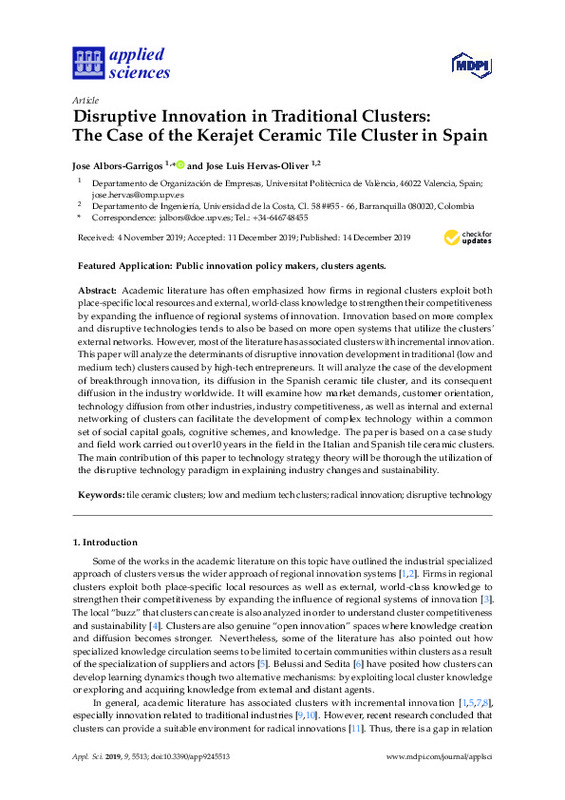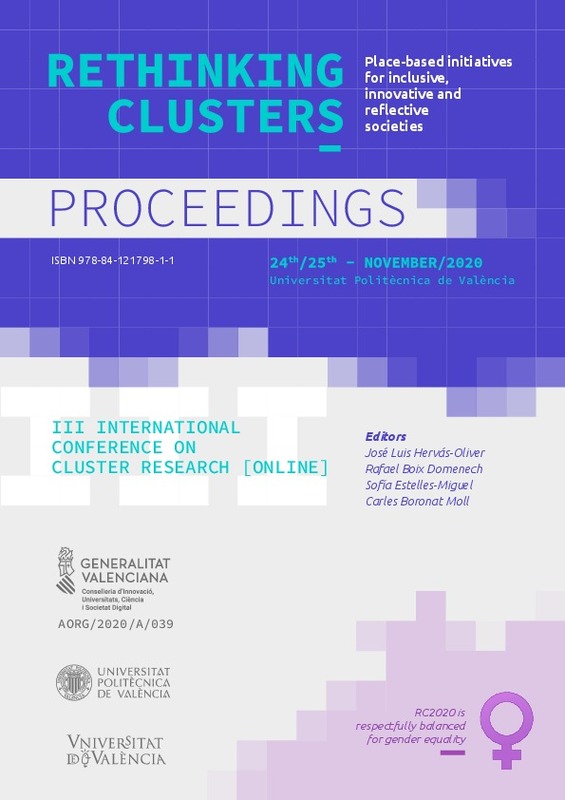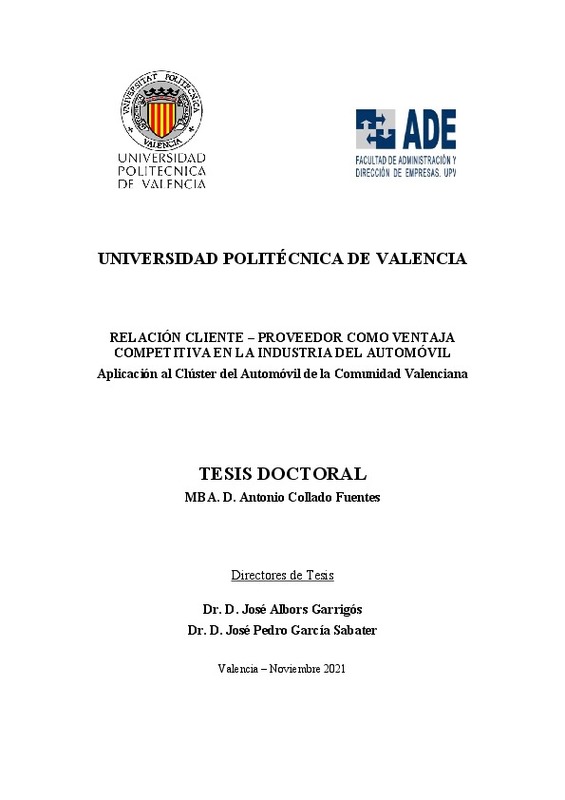JavaScript is disabled for your browser. Some features of this site may not work without it.
Buscar en RiuNet
Listar
Mi cuenta
Estadísticas
Ayuda RiuNet
Admin. UPV
Desde el lunes 3 y hasta el jueves 20 de marzo, RiuNet funcionará en modo de solo lectura a causa de su actualización a una nueva versión.
Disruptive Innovation in Traditional Clusters: The Case of the Kerajet Ceramic Tile Cluster in Spain
Mostrar el registro sencillo del ítem
Ficheros en el ítem
| dc.contributor.author | Albors Garrigós, José
|
es_ES |
| dc.contributor.author | Hervás Oliver, Jose Luis
|
es_ES |
| dc.date.accessioned | 2020-05-29T03:33:27Z | |
| dc.date.available | 2020-05-29T03:33:27Z | |
| dc.date.issued | 2019-12-14 | es_ES |
| dc.identifier.uri | http://hdl.handle.net/10251/144583 | |
| dc.description.abstract | [EN] Academic literature has often emphasized how firms in regional clusters exploit both place-specific local resources and external, world-class knowledge to strengthen their competitiveness by expanding the influence of regional systems of innovation. Innovation based on more complex and disruptive technologies tends to also be based on more open systems that utilize the clusters¿ external networks. However, most of the literature has associated clusters with incremental innovation. This paper will analyze the determinants of disruptive innovation development in traditional (low and medium tech) clusters caused by high-tech entrepreneurs. It will analyze the case of the development of breakthrough innovation, its diffusion in the Spanish ceramic tile cluster, and its consequent diffusion in the industry worldwide. It will examine how market demands, customer orientation, technology diffusion from other industries, industry competitiveness, as well as internal and external networking of clusters can facilitate the development of complex technology within a common set of social capital goals, cognitive schemes, and knowledge. The paper is based on a case study and field work carried out over10 years in the field in the Italian and Spanish tile ceramic clusters. The main contribution of this paper to technology strategy theory will be thorough the utilization of the disruptive technology paradigm in explaining industry changes and sustainability. | es_ES |
| dc.language | Inglés | es_ES |
| dc.publisher | MDPI AG | es_ES |
| dc.relation.ispartof | Applied Sciences | es_ES |
| dc.rights | Reconocimiento (by) | es_ES |
| dc.subject | Public innovation policy makers | es_ES |
| dc.subject | Clusters agents | es_ES |
| dc.subject | Tile ceramic clusters | es_ES |
| dc.subject | Low and medium tech clusters | es_ES |
| dc.subject | Radical innovation | es_ES |
| dc.subject | Disruptive technology | es_ES |
| dc.subject.classification | ORGANIZACION DE EMPRESAS | es_ES |
| dc.title | Disruptive Innovation in Traditional Clusters: The Case of the Kerajet Ceramic Tile Cluster in Spain | es_ES |
| dc.type | Artículo | es_ES |
| dc.identifier.doi | 10.3390/app9245513 | es_ES |
| dc.rights.accessRights | Abierto | es_ES |
| dc.contributor.affiliation | Universitat Politècnica de València. Departamento de Organización de Empresas - Departament d'Organització d'Empreses | es_ES |
| dc.description.bibliographicCitation | Albors Garrigós, J.; Hervás Oliver, JL. (2019). Disruptive Innovation in Traditional Clusters: The Case of the Kerajet Ceramic Tile Cluster in Spain. Applied Sciences. 9(24):1-19. https://doi.org/10.3390/app9245513 | es_ES |
| dc.description.accrualMethod | S | es_ES |
| dc.relation.publisherversion | https://doi.org/10.3390/app9245513 | es_ES |
| dc.description.upvformatpinicio | 1 | es_ES |
| dc.description.upvformatpfin | 19 | es_ES |
| dc.type.version | info:eu-repo/semantics/publishedVersion | es_ES |
| dc.description.volume | 9 | es_ES |
| dc.description.issue | 24 | es_ES |
| dc.identifier.eissn | 2076-3417 | es_ES |
| dc.relation.pasarela | S\400414 | es_ES |
| dc.description.references | Asheim, B. T., & Coenen, L. (2005). Knowledge bases and regional innovation systems: Comparing Nordic clusters. Research Policy, 34(8), 1173-1190. doi:10.1016/j.respol.2005.03.013 | es_ES |
| dc.description.references | Asheim, B. T., Smith, H. L., & Oughton, C. (2011). Regional Innovation Systems: Theory, Empirics and Policy. Regional Studies, 45(7), 875-891. doi:10.1080/00343404.2011.596701 | es_ES |
| dc.description.references | Lissoni, F. (2001). Knowledge codification and the geography of innovation: the case of Brescia mechanical cluster. Research Policy, 30(9), 1479-1500. doi:10.1016/s0048-7333(01)00163-9 | es_ES |
| dc.description.references | Belussi, F., & Sedita, S. R. (2012). Industrial Districts as Open Learning Systems: Combining Emergent and Deliberate Knowledge Structures. Regional Studies, 46(2), 165-184. doi:10.1080/00343404.2010.497133 | es_ES |
| dc.description.references | Steinle, C., & Schiele, H. (2002). When do industries cluster? Research Policy, 31(6), 849-858. doi:10.1016/s0048-7333(01)00151-2 | es_ES |
| dc.description.references | Giuliani, E. (2007). The wine industry: persistence of tacit knowledge or increased codification? Some implications for catching-up countries. International Journal of Technology and Globalisation, 3(2/3), 138. doi:10.1504/ijtg.2007.014330 | es_ES |
| dc.description.references | Hervas-Oliver, J.-L., & Albors-Garrigos, J. (2008). The role of the firm’s internal and relational capabilities in clusters: when distance and embeddedness are not enough to explain innovation. Journal of Economic Geography, 9(2), 263-283. doi:10.1093/jeg/lbn033 | es_ES |
| dc.description.references | Grashof, N., Hesse, K., & Fornahl, D. (2019). Radical or not? The role of clusters in the emergence of radical innovations. European Planning Studies, 27(10), 1904-1923. doi:10.1080/09654313.2019.1631260 | es_ES |
| dc.description.references | Dubé, & Paré. (2003). Rigor in Information Systems Positivist Case Research: Current Practices, Trends, and Recommendations. MIS Quarterly, 27(4), 597. doi:10.2307/30036550 | es_ES |
| dc.description.references | Molina-Morales, F. X. (2002). Industrial districts and innovation: the case of the Spanish ceramic tiles industry. Entrepreneurship & Regional Development, 14(4), 317-335. doi:10.1080/08985620210144992 | es_ES |
| dc.description.references | Estudio Económico del Sector del Azulejo 2018, Castellón (Spanish) http//www.ascer.es | es_ES |
| dc.description.references | Hervás-Oliver, J. L., & Albors-Garrigós, J. (2007). Do clusters capabilities matter? An empirical application of the resource-based view in clusters. Entrepreneurship & Regional Development, 19(2), 113-136. doi:10.1080/08985620601137554 | es_ES |
| dc.description.references | Oliver, J. L. H., Garrigós, J. A., & Porta, J. I. D. (2008). External Ties and the Reduction of Knowledge Asymmetries among Clusters within Global Value Chains: The Case of the Ceramic Tile District of Castellon. European Planning Studies, 16(4), 507-520. doi:10.1080/09654310801983308 | es_ES |
| dc.description.references | Assopiastrelle and Asia Observatore, Corporate Information www.assopiastrelle.it | es_ES |
| dc.description.references | Albors, J. G. (2002). The Journal of Technology Transfer, 27(3), 263-273. doi:10.1023/a:1015600521407 | es_ES |
| dc.description.references | Belussi, F., & Rita Sedita, S. (2008). The Symbiotic Division of Labour between Heterogeneous Districts in the Dutch and Italian Horticultural Industry. Urban Studies, 45(13), 2715-2734. doi:10.1177/0042098008098202 | es_ES |
| dc.description.references | Breschi, S., Malerba, F., & Orsenigo, L. (2000). Technological Regimes and Schumpeterian Patterns of Innovation. The Economic Journal, 110(463), 388-410. doi:10.1111/1468-0297.00530 | es_ES |
| dc.description.references | Iammarino, S., & McCann, P. (2006). The structure and evolution of industrial clusters: Transactions, technology and knowledge spillovers. Research Policy, 35(7), 1018-1036. doi:10.1016/j.respol.2006.05.004 | es_ES |
| dc.description.references | Robertson, P. L., & Patel, P. R. (2007). New wine in old bottles: Technological diffusion in developed economies. Research Policy, 36(5), 708-721. doi:10.1016/j.respol.2007.01.008 | es_ES |
| dc.description.references | JOHN, C. H., & POUDER, R. W. (2006). Technology Clusters versus Industry Clusters: Resources, Networks, and Regional Advantages. Growth and Change, 37(2), 141-171. doi:10.1111/j.1468-2257.2006.00313.x | es_ES |
| dc.description.references | Beckman, C. M., & Haunschild, P. R. (2002). Network Learning: The Effects of Partners’ Heterogeneity of Experience on Corporate Acquisitions. Administrative Science Quarterly, 47(1), 92. doi:10.2307/3094892 | es_ES |
| dc.description.references | Abernathy, W. J., & Clark, K. B. (1985). Innovation: Mapping the winds of creative destruction. Research Policy, 14(1), 3-22. doi:10.1016/0048-7333(85)90021-6 | es_ES |
| dc.description.references | Ettlie, J. E., Bridges, W. P., & O’Keefe, R. D. (1984). Organization Strategy and Structural Differences for Radical Versus Incremental Innovation. Management Science, 30(6), 682-695. doi:10.1287/mnsc.30.6.682 | es_ES |
| dc.description.references | Tushman, M. L., & Anderson, P. (1986). Technological Discontinuities and Organizational Environments. Administrative Science Quarterly, 31(3), 439. doi:10.2307/2392832 | es_ES |
| dc.description.references | Dewar, R. D., & Dutton, J. E. (1986). The Adoption of Radical and Incremental Innovations: An Empirical Analysis. Management Science, 32(11), 1422-1433. doi:10.1287/mnsc.32.11.1422 | es_ES |
| dc.description.references | Green, S. G., Gavin, M. B., & Aiman-Smith, L. (1995). Assessing a multidimensional measure of radical technological innovation. IEEE Transactions on Engineering Management, 42(3), 203-214. doi:10.1109/17.403738 | es_ES |
| dc.description.references | Coccia, M. (2015). Radical innovations as drivers of breakthroughs: characteristics and properties of the management of technology leading to superior organisational performance in the discovery process of R&D labs. Technology Analysis & Strategic Management, 28(4), 381-395. doi:10.1080/09537325.2015.1095287 | es_ES |
| dc.description.references | Adner, R. (2002). When are technologies disruptive? a demand-based view of the emergence of competition. Strategic Management Journal, 23(8), 667-688. doi:10.1002/smj.246 | es_ES |
| dc.description.references | Adner, R., & Kapoor, R. (2015). Innovation ecosystems and the pace of substitution: Re-examining technology S-curves. Strategic Management Journal, 37(4), 625-648. doi:10.1002/smj.2363 | es_ES |
| dc.description.references | Danneels, E. (2004). Disruptive Technology Reconsidered: A Critique and Research Agenda. Journal of Product Innovation Management, 21(4), 246-258. doi:10.1111/j.0737-6782.2004.00076.x | es_ES |
| dc.description.references | Markides, C. (2006). Disruptive Innovation: In Need of Better Theory*. Journal of Product Innovation Management, 23(1), 19-25. doi:10.1111/j.1540-5885.2005.00177.x | es_ES |
| dc.description.references | Tellis, G. J. (2006). Disruptive Technology or Visionary Leadership?*. Journal of Product Innovation Management, 23(1), 34-38. doi:10.1111/j.1540-5885.2005.00179.x | es_ES |
| dc.description.references | Von Hippel, E. (1986). Lead Users: A Source of Novel Product Concepts. Management Science, 32(7), 791-805. doi:10.1287/mnsc.32.7.791 | es_ES |
| dc.description.references | Chesbrough, H. (2010). Business Model Innovation: Opportunities and Barriers. Long Range Planning, 43(2-3), 354-363. doi:10.1016/j.lrp.2009.07.010 | es_ES |
| dc.description.references | Schmidt, G. M., & Druehl, C. T. (2008). When Is a Disruptive Innovation Disruptive? Journal of Product Innovation Management, 25(4), 347-369. doi:10.1111/j.1540-5885.2008.00306.x | es_ES |
| dc.description.references | Isaksen, A. (2018). From success to failure, the disappearance of clusters: a study of a Norwegian boat-building cluster. Cambridge Journal of Regions, Economy and Society, 11(2), 241-255. doi:10.1093/cjres/rsy007 | es_ES |
| dc.description.references | Glasmeier, A. (1991). Technological discontinuities and flexible production networks: The case of Switzerland and the world watch industry. Research Policy, 20(5), 469-485. doi:10.1016/0048-7333(91)90070-7 | es_ES |
| dc.description.references | Hervas-Oliver, J.-L., & Albors-Garrigos, J. (2014). Are technology gatekeepers renewing clusters? Understanding gatekeepers and their dynamics across cluster life cycles. Entrepreneurship & Regional Development, 26(5-6), 431-452. doi:10.1080/08985626.2014.933489 | es_ES |
| dc.description.references | Hervas-Oliver, J.-L., Sempere-Ripoll, F., Estelles-Miguel, S., & Rojas-Alvarado, R. (2019). Radical vs incremental innovation in Marshallian Industrial Districts in the Valencian Region: what prevails? European Planning Studies, 27(10), 1924-1939. doi:10.1080/09654313.2019.1638887 | es_ES |
| dc.description.references | Albors, J., & Hervás, J. L. (2006). La industria cerámica europea en el siglo XXI. Retos tecnológicos y desafíos de la próxima década. Boletín de la Sociedad Española de Cerámica y Vidrio, 45(1), 13-21. doi:10.3989/cyv.2006.v45.i1.323 | es_ES |
| dc.description.references | Utterback, J. M., & Abernathy, W. J. (1975). A dynamic model of process and product innovation. Omega, 3(6), 639-656. doi:10.1016/0305-0483(75)90068-7 | es_ES |
| dc.description.references | Assink, M. (2006). Inhibitors of disruptive innovation capability: a conceptual model. European Journal of Innovation Management, 9(2), 215-233. doi:10.1108/14601060610663587 | es_ES |
| dc.description.references | Munari, F., Sobrero, M., & Malipiero, A. (2011). Absorptive capacity and localized spillovers: focal firms as technological gatekeepers in industrial districts. Industrial and Corporate Change, 21(2), 429-462. doi:10.1093/icc/dtr053 | es_ES |
| dc.description.references | Landry, R., Amara, N., & Lamari, M. (2002). Does social capital determine innovation? To what extent? Technological Forecasting and Social Change, 69(7), 681-701. doi:10.1016/s0040-1625(01)00170-6 | es_ES |
| dc.description.references | Angel, D. P. (2002). Inter-firm Collaboration and Technology Development Partnerships Within US Manufacturing Industries. Regional Studies, 36(4), 333-344. doi:10.1080/00343400220131115 | es_ES |
| dc.description.references | Tallman, S., Jenkins, M., Henry, N., & Pinch, S. (2004). Knowledge, Clusters, and Competitive Advantage. Academy of Management Review, 29(2), 258-271. doi:10.5465/amr.2004.12736089 | es_ES |
| dc.description.references | Cohen, W. M., & Levinthal, D. A. (1990). Absorptive Capacity: A New Perspective on Learning and Innovation. Administrative Science Quarterly, 35(1), 128. doi:10.2307/2393553 | es_ES |
| dc.subject.ods | 08.- Fomentar el crecimiento económico sostenido, inclusivo y sostenible, el empleo pleno y productivo, y el trabajo decente para todos | es_ES |











